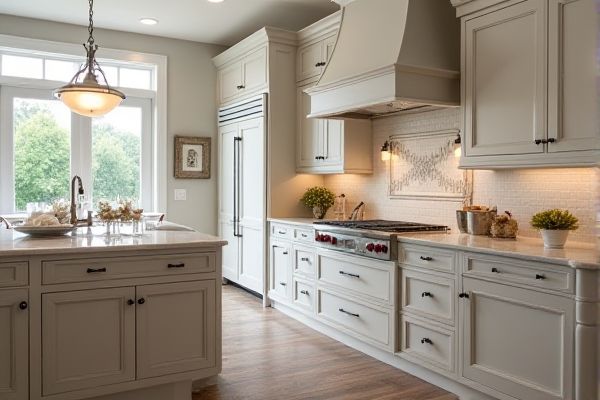
Full overlay cabinetry offers a sleek, modern look by covering most of the cabinet frame, creating a seamless appearance with minimal gaps. If you're considering a kitchen upgrade, explore the differences between full overlay and partial overlay cabinetry to find the best fit for Your style and functionality needs. Read on to discover which option suits your space perfectly.
Table of Comparison
| Feature | Full Overlay Cabinetry | Partial Overlay Cabinetry |
|---|---|---|
| Door Coverage | Doors cover nearly entire cabinet frame | Doors cover part of the cabinet frame |
| Appearance | Sleek, modern, seamless look | Traditional, classic look with visible frame |
| Cost | Generally more expensive due to design complexity | Typically more affordable |
| Installation | Requires precise alignment for seamless appearance | Less precise; easier to install |
| Hardware Visibility | More concealed hardware options | Hardware more visible |
| Durability | Equal to partial overlay; depends on material | Equal to full overlay; depends on material |
| Cabinet Frame Exposure | Minimal frame exposure | Frame edges visible between doors |
Introduction to Cabinetry Overlays
Cabinetry overlays refer to the way cabinet doors and drawer fronts cover the cabinet frames, impacting both style and functionality. Full overlay cabinetry offers doors that cover nearly the entire frame, creating a seamless, modern look with minimal visible gaps and more storage space. Partial overlay cabinetry features doors that partially cover the frame, providing a traditional appearance with more frame visibility and often easier door alignment and repair.
What is Full Overlay Cabinetry?
Full overlay cabinetry features doors and drawers that completely cover the cabinet frame, creating a sleek and seamless appearance with minimal gaps. This design maximizes storage space and enhances the visual appeal of kitchens by providing a modern, streamlined look. Cabinet face frames are mostly hidden, allowing for larger door and drawer fronts that contribute to the cabinetry's full coverage aesthetic.
What is Partial Overlay Cabinetry?
Partial overlay cabinetry features cabinet doors and drawer fronts that cover only a portion of the cabinet frame, leaving exposed borders or rails visible. This style creates a classic, traditional look with slightly recessed doors compared to full overlay units, offering easier access to cabinet hardware. Partial overlay cabinets are often chosen for their cost-effectiveness and timeless aesthetic in kitchens or bathrooms.
Key Differences Between Full and Partial Overlay
Full overlay cabinetry features doors and drawers that cover almost the entire face frame, creating a seamless, modern look with minimal visible gaps, while partial overlay cabinetry exposes more of the cabinet frame, resulting in a more traditional appearance with wider reveal lines. The key differences between full and partial overlay include the amount of visible cabinet frame, the overall aesthetic impact, and the installation complexity, with full overlay often requiring precise fitting to maintain consistent gaps. Your choice between full and partial overlay cabinetry will affect the visual style, space efficiency, and cost of your kitchen or bathroom design.
Aesthetic Impact of Overlay Choices
Full overlay cabinetry offers a sleek, seamless aesthetic by minimizing visible cabinet frames, creating a modern and streamlined look. Partial overlay cabinetry exposes more of the cabinet frame, contributing to a traditional or classic design with defined lines and depth. Choosing full overlay emphasizes contemporary elegance, while partial overlay adds character and architectural detail to kitchen spaces.
Storage and Accessibility Comparisons
Full overlay cabinetry offers maximized storage by utilizing more cabinet face space, allowing wider drawers and doors that provide easier access to contents. Partial overlay cabinets have visible gaps between doors and frames, which can limit storage efficiency but may offer easier access in tighter spaces. When optimizing your kitchen for storage and accessibility, consider how full overlay designs deliver a seamless look with enhanced usability, while partial overlays balance function and cost.
Cost Implications: Full vs Partial Overlay
Full overlay cabinetry typically incurs higher costs due to increased material use and the need for precise craftsmanship to achieve minimal gaps between doors and frames. Partial overlay cabinets are generally more budget-friendly as they use less material and have exposed cabinet frames, reducing manufacturing complexity. Cost differences also depend on the cabinet style, hardware, and installation specifics.
Installation and Maintenance Considerations
Full overlay cabinetry requires precise installation to ensure doors and drawers cover the cabinet frame completely, demanding accurate measurements and alignment to maintain a seamless look. Maintenance involves careful cleaning around closely fitting doors, as dust and grime can accumulate in tight gaps, necessitating frequent attention to preserve the sleek appearance. Partial overlay cabinetry allows for easier installation due to visible cabinet frames, and its maintenance is simpler because the gaps between doors and frames reduce the risk of trapped dirt and facilitate straightforward cleaning.
Pros and Cons of Each Overlay Type
Full overlay cabinetry offers a sleek, modern look with doors and drawers covering most of the cabinet frame, maximizing storage space and minimizing gaps, but it can be more expensive due to precise manufacturing requirements. Partial overlay cabinetry shows more of the cabinet frame between doors and drawers, providing a classic aesthetic and potentially easier installation, though it may result in visible gaps and less storage space. Your choice depends on whether you prioritize a seamless appearance and space efficiency or budget and traditional style.
Choosing the Right Overlay for Your Space
Full overlay cabinetry offers a sleek, modern look with doors and drawers that cover almost the entire cabinet frame, maximizing storage space and minimizing visible gaps. Partial overlay cabinets showcase more of the cabinet frame, providing a traditional appearance and often allowing for easier access and repair. Your choice should balance aesthetics, space efficiency, and budget to best suit your kitchen or bathroom design needs.
 homyna.com
homyna.com